Abstract
After prolonged operation, external objects may obstruct the photovoltaic (PV) array, resulting in prolonged partial shading. The dynamic reconfiguration of PV arrays uses a switch matrix to change the electrical positions of the PV cells in the array, and it is an effective method to solve the problem of partial shading. Most of the current dynamic reconfigurations only consider the optimization of power output. Neglecting the switch actions will increase the number of switch matrix actions, making the switch control more complex and reducing the lifespan of devices. To address power optimization and switch action optimization simultaneously during dynamic reconfiguration, this paper introduces a novel objective function. This function combines power optimization and switch action optimization in a weighted manner. Based on the novel function, the algorithm prioritizes optimizing the electrical positions of PV cells with larger shading values. This ensures that the PV array can improve its output while significantly reducing the number of switch actions. The Pelican Optimization Algorithm (POA) is improved and employed to optimize the proposed objective function. In terms of the output power optimization, the effectiveness of the novel objective function with the improved POA is validated by comparing and analyzing the reconfiguration results with the conventional objective functions under four shading scenarios. The results demonstrate that the novel objective function with the improved POA increases the output power by 30% in short and wide shadow and achieves the highest power output. Moreover, the tests conducted on dynamic reconfiguration results with different weights validate the effectiveness of the novel objective function in minimizing switching actions while improving power output.
1. Introduction
In recent years, the fluctuation of fossil fuel prices and their negative impact on the environment has led to a rapid development in solar energy. The photovoltaic (PV) industry has become an important component of the power grid structure [1,2]. However, the power output of PV systems is very dependent on environmental conditions. The PV cells are usually obstructed by objects such as dust, colloidal substance and nearby buildings after a long time of operation. These objects create shadows on the surface and prevent the irradiation from reaching the interior of the PV cell, resulting in the PV array at partial shadow condition (PSC) [3]. When a PV cell is shaded and operates as a load in a PV array, the current passing through it exceeds its own generated current, resulting in the formation of hotspots and potential damage to the affected PV cell [4,5]. Bypass diodes are connected to shunt the current. The bypass diode not only reduces the possibility of hotspot failures, but also decreases the overall efficiency of the PV array and the power generation capacity. PV arrays operate at uneven irradiation, and the output characteristics of PV cells become asymmetric. This leads to multiple peaks appearing on output characteristics, such as the power-voltage curve and current-voltage curve, making it difficult to track the maximum power point [6]. Common solutions for improving the output of the PV arrays at PSC include: (1) optimizing maximum power point tracking methods; (2) using inverters and converters; and (3) using the PV array reconfiguration technique. The first two solutions do not effectively address the impact of PV cells at PSC on other PV cells. The PV array reconfiguration technique is considered to be the most ideal solution to the PSC problem because it can achieve a more even distribution of shading and keep the row currents nearly equal.
The PV array reconfiguration technique includes two methods [7]: static reconfiguration and dynamic reconfiguration. Static reconfiguration connects the PV cell based on preset electrical connections or a physical location. Once the static reconfiguration is complete, the electrical position and irradiation condition of the PV cells are stable while the PV system is operating. Reference [8] outlines several basic electrical connection topologies. It compares the mismatch loss and fill factor of PV array power outputs in simple series, simple parallel and series-parallel, total cross tied (TCT), bridged-link and honey-comb topologies. The result indicates that the PV array at TCT topology outperformed other topologies.
Static reconfiguration changes the physical location of PV cells so that the shadows are geographically close and evenly distributed over electrical topology. In terms of effect, the SuDoKu [9,10] is considered one of the most effective static reconfigurations. However, the SuDoKu has the disadvantage of requiring long wires to change the position of the PV cell. Optimized SuDoKu [11] and Improved SuDoKu [3] have addressed this disadvantage and, respectively, enhanced the applicability of the SuDoKu at different scales and shadows. The Arrow SuDoKu technology proposed by Venkata [12] makes static reconfiguration accomplish shading dispersion at continuous dynamic shadows. Dhanalakshmi [13,14] proposes the dominance square (DS) and competence square (CS). They can be applied to static reconfiguration at TCT topology. Compared with DS, CS has a smaller mismatch loss and higher fill factor in the reconfiguration results of the same shadow. Magic square (MS) proposed by Namani [15] and the Magic Square pattern proposed by Sarojini [16] are applied to the reconfiguration of the PV array at 4 × 4 and 6 × 6 TCT topology, respectively. MS technology can effectively disperse shadows and make the PV array achieve higher output power. Reference [17] shows that the MS technique is still a useful static reconfiguration for a PV array at different shadow shapes. In Reference [18], the author proposes a new magic square technology. It shows better performance than the TCT topology and the SuDoKu. The method of static reconfiguration is simple and easy to implement, but the shadow shapes of static reconfiguration are mostly regular and stable. If the shape of the shadow changes, the optimal electrical connection of the PV array will also change, and the static reconfiguration cannot maximize the output power of the PV array. In addition, static reconfiguration usually requires longer wire connections, causing additional power loss [7].
Dynamic reconfiguration technology mainly includes electrical array reconfiguration (EAR) [19]. When the shading distribution of the PV array is known, the dynamic uses the switch matrix to change the electrical position of PV cells. This method disperses shadows without changing the physical location. Karakose [20] uses fuzzy control to find the optimal combination of PV cells’ electrical position. The goal of fuzzy control is to minimize the difference in the mean values of irradiance occurring in each row of the PV array at TCT topology. The Rough Set Theory [21] proposed by Paula is an alternative approach for dynamic reconfiguration. Parlak [22] employs a configuration scanning algorithm to find the optimal solution from as many outcomes as possible. Eleonora [19] regards the dynamic reconfiguration at TCT topology as a special case of the knapsack problem, and uses dynamic programming and Munkres algorithm to minimize the switching action of the switch matrix while operating dynamic configuration. In Reference [23], Yousef uses the greedy algorithm to accomplish dynamic reconfiguration. This algorithm reduces the calculation time of finding the optimal solution for reconfiguration.
The computation time for finding the optimal electrical connection scheme and minimizing the switching matrix action is still a challenging task. However, the emergence of various metaheuristic algorithms has opened up new avenues for tackling this challenge. Deshkar [24] uses genetic algorithms (GA) to find the optimal solution. The objective function of GA is to minimize the difference of the row current of the PV array at TCT topology, and determine the optimal sequence of the electrical position to maximize the output power. Based on this single objective function for power optimization, the particle swarm optimization (PSO) proposed by Thanikanti [25] and the grasshopper optimization algorithm (GOA) proposed by Fathy [26] have greater efficiency and reliability in finding the optimal solution. The modified Harris hawk optimizer proposed by Yousri [27] improves the speed of iterations and the smoothness of electrical position changes. In order to reduce the number of control parameters of algorithms and avoid falling into particle optimum, Ahmed [28] proposes the butterfly optimization algorithm (BOA) for dynamic reconfiguration. In Reference [29], the author regards the minimization of the irradiance level mismatch index as the objective function. Rajan applies the gravity search algorithm (GSA) to the dynamic reconfiguration in the article [30]. The standard deviation of the TCT topology row current was used as the objective function for dynamic reconfiguration. Yousri [31] also establishes a novel objective function to improve the performance of the algorithm. The conventional second reconfiguration aims at the maximum output power, while the lifetime and control complexity of switching devices need to be considered when performing dynamic reconfiguration. In Reference [32], the author establishes the power optimization objective function and switching action minimization objective function, respectively, and uses the Pareto algorithm to find the optimal solution. But when considering some additional factors, such as the increased switching costs, the objective function to be taken into account will increase, and the computational time and complexity of the algorithm will also significantly increase.
In summary, current research mostly focuses on the single objective function of maximizing power output. When implementing the dynamic reconfiguration of the array, a significant number of switches are required to coordinate and work together in the switching matrix. A large number of switch actions not only reduce the switches’ lifespan, but also increase the complexity of control. Therefore, it is necessary to optimize the switch actions during dynamic reconfiguration and minimize the number of switch operations as much as possible.
The shading value of the PV cells plays a crucial role in determining the power output of the PV arrays. Specifically, the impact on the overall power output of the PV array becomes more significant as the shading value of a PV cell increases. By first dispersing the PV cells with higher shadow values, it is possible to efficiently improve the output of the PV array and minimize the switch actions. Based on this idea, this article introduces a suitable novel objective function. It is a weighted combination of the power output optimal function and switching action function. The novel objective function sets the weight value to adjust the optimization effect of power optimization and switching action optimization. In order to address the issue of the variable discretization caused by weight combinations, an improved Pelican Optimization Algorithm (POA) is utilized in this study, as it requires fewer parameters and enables the discretization of moving distances. Compared to the optimization method used in Reference [32], the improved algorithm can consider multiple factors by combining them in a weighted manner, and effectively reduce the complexity of the optimization process. To validate the reliability of the novel objective function, the power output of the reconfiguration results is analyzed under four typical shadow modes, which are short and wide (SW) shadow, long and wide (LW) shadow, short and narrow (SN) shadow, and long and narrow (LN) shadow [33]. The reconfiguration results are evaluated and compared with other optimization methods that focus on conventional power objectives, utilizing the fill factor and mismatch losses. Furthermore, the article discusses the relationship between power optimization and switching action optimization with different weights for achieving dynamic reconfiguration at diagonal shading. The results show that the value of the weight factor affects the probability of the electrical position changes of the PV cells with lower shading values during dynamic reconfiguration.
2. PV Array Modeling
2.1. Modeling of PV Array at TCT Topology
This article focuses on the dynamic reconfiguration of the PV array at the TCT topology. The physical position of the PV cell remains fixed during dynamic reconfiguration. By exchanging the electrical position of the PV cell at the TCT topology, the dynamic reconfiguration achieves partial shadow dispersion. PV cells are connected in parallel to form rows, and these rows are connected in series to form a TCT topology. Figure 1 illustrates the schematic diagram of the TCT topology [28,29]. The electrical position of the PV cell is specified by the subscript (i,j), where i represents the row number and j represents the column number.
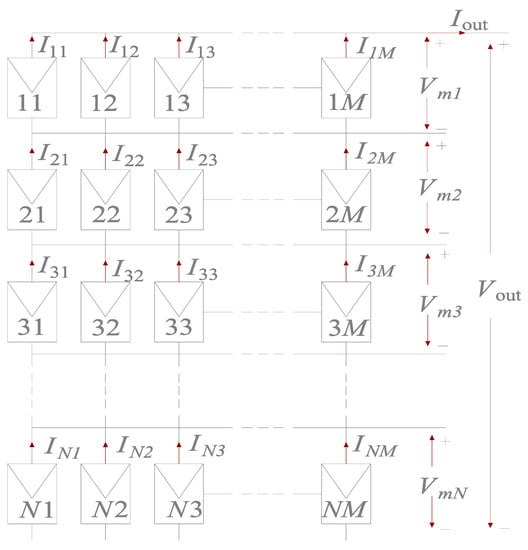
Figure 1.
The N × M PV array under TCT topology.
The output of the N × M PV array under the TCT topology is the following:
where Vout is the open circuit voltage of the PV array, Vmh is the open circuit voltage of row h, Iout is the short circuit current of the PV array, Iij is the output current of row i and column j, Iic is the row current of row i and Io is the current at a node.
2.2. Dynamic Reconfiguration at TCT Topology
Two primary objectives need to be considered during dynamic reconfiguration: maximizing PV array output power and minimizing the number of switch actions. According to the principle of irradiance equalization [34], a smaller difference in the sum of the irradiation values between rows within the TCT topology leads to increased output power. There are various methods available for detecting PV irradiance values, beyond optical sensors or galvanometers. Computer vision can effectively identify and measure PV shadow status by using monitoring and drones, and complete the detection of the overall shadow distribution of the PV array. A row irradiance value can reflect the array’s shadow distribution and replace the row current value. Therefore, the power optimization process aims to minimize the deviation of row irradiance values.
In scenarios where the number of PV cells with the same shade value in a column increases, it becomes crucial to arrange their electrical positions effectively during dynamic reconfiguration. When optimizing the switching action, the number of switching actions depends on the electrical position changes of PV cells before and after reconfiguration. A higher number of PV cells with altered electrical positions results in more switch actions. The objective is to maintain electrical positions as consistently as possible and minimize the switching operations required by the switch matrix. The objective function for the number of electrical positions is established by considering the number of invariant electrical positions during optimization. Thus, the objective function for power optimization and minimum switching action during PV reconfiguration can be described as follows:
where Gmaxc represents the maximum value of the array row irradiation value, Gminc represents the minimum value of the array row irradiation value, sign represents the sign function, if x = 0, sign(x) = 0, if x > 0, sign(x) = 1, and and represent the number of the same PV cell’s electrical location before and after reconfiguration.
The primary objective of mitigating partial shadows is to achieve particle shadow dispersion to different rows. The electrical position swapping of the PV cells is limited to the same column, enabling the uniform distribution of shadows across a row. During the dynamic reconfiguration process, certain switch constraints must be taken into account. These constraints include:
The evaluation criteria of PV reconfiguration results are as follows:
- (1)
- Fill factor
The fill factor (FF) aims to estimate the power loss of the PV array at PSC. Its value is the ratio of the maximum power obtained under shaded conditions to the product of the open circuit voltage Vout and the short circuit current Iout of the PV array [3].
- (2)
- Mismatch losses
The mismatch loss is the difference between the maximum power under uniform irradiance () and the global maximum power under PSCs (). The mismatch loss can be determined as the following [3]:
- (3)
- Electrical position invariant ratio
The electrical position invariant ratio is defined as the ratio of the number of the same PV cell whose electrical position does not change in the TCT topology during reconfiguration. The size of the standard value is used to estimate the number of switching actions during reconfiguration. The value is equal to f2.
2.3. Novel Objective Function
The objective function combined using weights is expressed as follows:
In Formula (6), it considers the factors of power and switch actions. The normalized factors are combined using weights to form a single objective function. When the weight values are significant, a smaller (1 − f2) value corresponds to fewer switch actions, which limits the changes in the electrical positions of PV cells that have a lesser impact on f1. This leads to prioritizing the optimization of PV cells with larger shading values. By adjusting the weight values from large to small, the reconfiguration can achieve the desired outcome. However, the weights are still considered as parameters and need to be set before the optimization process begins.
3. Dynamic Reconfiguration with Novel Function
The conventional objective function focuses solely on power optimization by minimizing the difference in row currents. In contrast, the novel objective function considers both power optimization and switching actions optimization. It considers the shadow values and electrical positions, which are inherent properties of PV cells. To incorporate these properties, this paper uses structure to address these considerations. While dealing with discrete variables, a method has been devised to address this issue by discretizing the parameters of POA. This approach ensures that the algorithm can effectively handle the optimization problem and yield meaningful results.
3.1. Pelican Optimization Algorithm
The Pelican Optimization Algorithm (POA) is a metaheuristic algorithm proposed by Pavel [35]. He was inspired by the behavior and strategy of the pelican hunt. POA explores and exploits the maximum point of the objective function by imitating the behavior of the pelican. The POA strategy is simulated in two stages in the process of searching for the global point: moving towards prey (exploration phase) and winging on the water surface (exploitation phase).
In the first phase, groups of pelicans identify the location of their prey and then move toward it. Based on the distance between the pelican population and the prey, the position of the pelican is updated by the fitness value. After iterating and moving, the pelican can arrive and gather to the maximum point. The strategy of the pelican moving towards its prey is mathematically simulated in Formula (7):
where is the new status of the ith pelican in the jth dimension based on phase 1, I is a random number which is equal to 1 or 2, Pj is the location of prey in the jth dimension, and Fp is its objective function value. The parameter I is a number that can be equal to 1 or 2 randomly during iteration.
In the second phase, the algorithm checks the area around the pelican based on the pelican’s completed move. This strategy increases the global search and development capabilities. This type of behavior shown by pelicans during hunting is mathematically simulated in Formula (8):
where is the new status of the ith pelican in the jth dimension based on phase 2, R is a constant, which is equal to 0.2, and R·(1 − t/T) is the neighborhood radius of xi,j. The coefficient R·(1 − t/T) is effective for the exploitability of POA, making it closer to the global optimal solution. In the initial iterations, the value of this coefficient is large and as a result, a larger area around each member is considered.
At the end of each phase, the algorithm updates the pelican position and selects the optimal solution. When iterating to the maximum number of iterations or reaching the convergence condition, the algorithm will stop iterating and output optimization results.
3.2. PV Array Reconfiguration with Novel Function
3.2.1. Conventional Power Optimization in Continuous Space
Metaheuristic algorithms utilize the Euclidean distance as a measure to determine the proximity between groups within search space. The algorithms search for the maximum value in a continuous space. When only power optimization is considered during dynamic reconfiguration, the irradiance value of the PV cells can be treated as a continuous variable. However, to adhere the switch constraints, the generated continuous variables are finally rounded by the value.
In order to expedite convergence and provide comparison with the novel objective function in power optimization, each optimization in this article focuses on a single column of the PV array. The PV array is optimized column by column by the variance of the shadow values in each column. In addition to utilizing POA for the novel objective function, POA is also employed for conventional power optimization. This allows us to make a meaningful comparison between the performance of POA in the novel objective function and its performance in the conventional power optimization context. Using POA in both scenarios allows for the evaluation of its effectiveness and the determination of any improvements or differences achieved when considering the novel objective function. This comparison serves to provide valuable insights into the strengths and limitations of POA in different optimization. The specific steps involved in this approach are as follows:
- Step 1.
- Initialization phase. Determine the size of the PV array. Calculate the variance of the row shadow value of the PV array. Select the column with the smallest variance as the optimized column. Optimize column according to the size of the variance value.
- Step 2.
- Create an initial group. Create an initial population number Npop. The variable number of members is N and ranges from 0 to 1, representing the shadow value in the array.
- Step 3.
- Calculate the fitness value. Each member in the population is combined with the determined column to calculate the row shadow value. The fitness value of the member is calculated through the objective function. Its objective function is the following:
- Step 4.
- Operate POA optimization. The optimization process is mainly to generate the prey position and position movement, and search for the optimal point. In the selection of prey, one of the members is randomly selected as the prey. Depending on the fitness value of the prey, members move away from or close to the prey.
- Step 5.
- Complete the rounding of the optimized value. At this phase, based on the numerical value of the variable in the optimal value and the original shadow value, the result is discretized based on the numerical value under the switch constraint (Formula (3)). The discrete optimal values save as the optimized columns of the PV array. Repeat steps 2, 3 and 4 until all the columns of the array are optimized.
- Step 6.
- Reconfiguration of the array. The optimized solution uses the switch matrix to change the electrical connection mode of the PV array to complete the dynamic reconfiguration. The flowchart of dynamic reconfiguration based on POA in continuous space is shown in Figure 2:
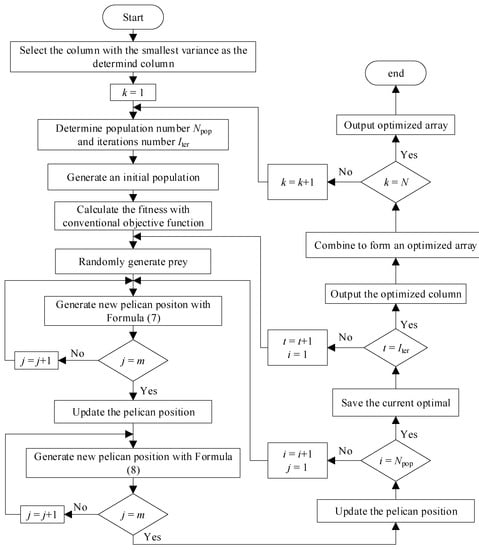 Figure 2. Flow chart of POA reconfiguration in continuous space.
Figure 2. Flow chart of POA reconfiguration in continuous space.
3.2.2. Novel Objective Function in Discrete Space
Building upon power optimization, switching action optimization is added to the objective function during dynamic reconfiguration. As the relative electrical positions and shading values are discrete, it becomes challenging to satisfy the switching constraints when optimizing and discretizing the variables as continuous values. To address this issue, the electrical positions and shadow values of the PV cells are combined into a unified structure that ensures compliance with the switching constraints. The optimization process focuses on optimizing the arrangement of N structures. Since the variables are discrete, the optimization process itself becomes discrete as well. It involves searching for the optimal column sequence within a limited space, resulting in faster convergence. To better suit the discrete variables, this paper establishes a novel objective function that accommodates their nature. Among various metaheuristic algorithms, POA exhibits excellent performance in terms of its global exploration capability. Additionally, POA has few control parameters and is straightforward to implement. It was discovered that the parameters and movement process of POA can be better discretized. Since only the discretization of parameters is performed, the time complexity of the optimization process remains unchanged, equal to . Taking advantage of these findings, POA is applied to search for the global optimal solution of the novel objective function.
The specific implementation steps of optimization are as follows:
- Step 1.
- Initialization phase. Determine the size of the research array, and establish a variable structure with the original position of the PV cell and shadow value—a structure representing a PV cell. The shadow value and original position of the structure are consistent and unchanged.
- Step 2.
- Select the column to optimize. Calculate the variance of the row shadow value of the PV array. Select the column with the smallest variance as the optimized column. Optimize the column according to the size of the variance value.
- Step 3.
- Create an initial group. Create an initial population number Npop, arrange the sequences randomly and satisfy the switching constraints.
- Step 4.
- Calculate the fitness value. The dual-objective optimization function in Formula (1) is transformed into a single-objective function according to the weight combination. Normalization is used to realize the combination of power optimization and switching action optimization non-dimensional attributes. Compute the fitness value for each member.
- Step 5.
- Perform POA optimization. Randomly select members from the generated population as prey. Calculate the Euclidean distance between the member and the prey with the same position number as dis, and decide whether the pelican member is close to or far away from the prey based on the fitness value. Based on Formula (7), the moving distance Sj of the member in the jth column is modified as a discrete mathematical model:Swapping the electrical location in columns based on movement distance. The adjustment of the POA exploitation phase in discrete space is:In this article, R takes the value of 1.
- Step 6.
- Complete column optimal value selection. At this step, the optimization is considered complete if the fitness function is acceptable or reaches the maximum iteration criterion. Repeat steps 2, 3 and 4 until all the columns of the array are optimized.
- Step 7.
- Reconfiguration of the array. The optimized solution uses the switch matrix to change the electrical connection mode of the PV array to complete dynamic reconfiguration. The flowchart of dynamic reconfiguration based on improved POA in discrete space is shown in Figure 3:
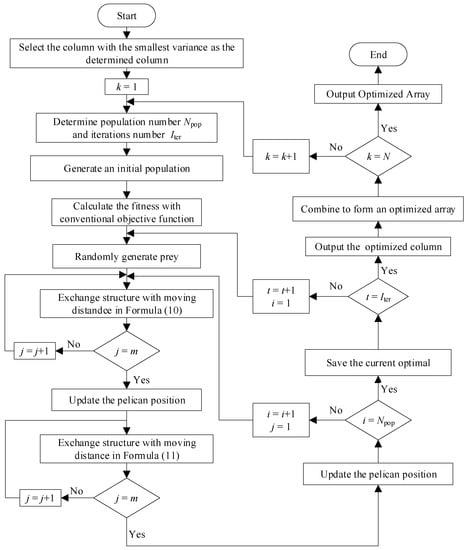 Figure 3. Flow chart of improved POA reconfiguration in discrete space.
Figure 3. Flow chart of improved POA reconfiguration in discrete space.
4. Case Analysis
4.1. Power Optimization in Different Shades
This section aims to evaluate the effectiveness of POA with the novel objective function for power optimization. MATLAB software (Version 9.13) is used to simulate the power output of the PV array and analyze its fill factor and mismatch losses under four different shadow conditions: SW, LW, SN and LN. After completing the dynamic reconfiguration process, the results obtained using the novel objective function are compared with those obtained using conventional objective functions. The findings indicate that the novel objective function enables the attainment of a power-optimal solution. Regarding the selection of algorithm parameters, the maximum number of iterations is set to 100, and the number of populations is set to 25. Additionally, the operating temperature for the PV array is assumed to be 25 °C. In this particular scenario, the novel objective function prioritizes power optimization alone, and α in the novel objective function (Formula (6)) is set as 0. All the simulations are undertaken in MATLAB 9.13 by a personal computer with Intel (R) Core i7-9750H CPU with 16 GB of RAM.
4.1.1. Case 1: Short Wide Shadow and Long Narrow Shadow
The distribution of short wide shadows and long narrow shadows are illustrated as SW in Figure 4a and LN in Figure 4b, respectively. Each block in the figures represents a PV cell, and the color depth of the block’s color represents the radiation intensity received by each PV cell. This paper uses the optimization solutions of objective function (Formula (9)) with BOA, GSA, political optimizer (PO) and PSO to compare with the novel function with POA. The optimization solutions are illustrated in Figure 4a,b. Specifically, POA(C) and POA(D) present the optimization results of POA in conventional and novel objective function, respectively. The results clearly demonstrate that dynamic reconfiguration utilized the algorithm, and the switch matrix can effectively disperse the concentrated shadow among different array rows.
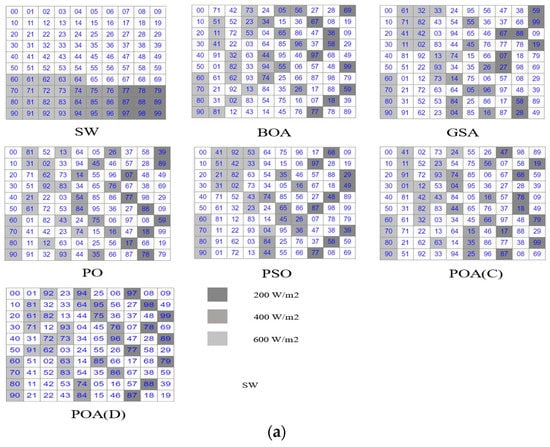
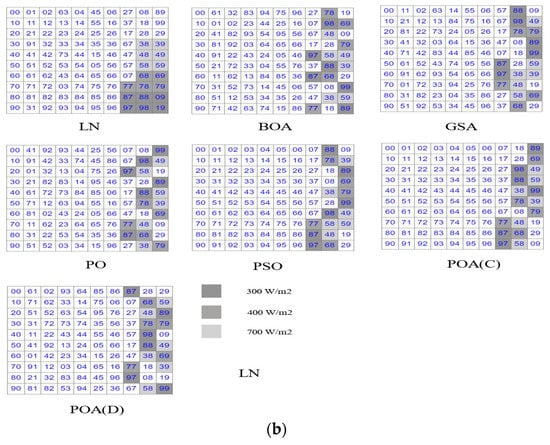
Figure 4.
Optimization results of PV array at different shadows. (a) Short and wide shadow; (b) long and narrow shadow.
The curves in Figure 5a,b are the power voltage curve of the PV array at the TCT topology and the optimized solution obtained with different algorithms. The dynamic reconfiguration of the PV array proves successful in mitigating the multi-peak problem and facilitating maximum power point tracking. Following the optimized electrical connection, a significant increase in maximum power output is achieved. To further evaluate the effectiveness of the algorithms in dispersing shadows, Figure 5c presents a boxplot of the optimized row shadow values. It becomes evident that the PO, PSO and POA algorithms are capable of searching for the improved solutions to disperse shadows effectively. The fill factor and mismatch losses are shown in Figure 5d, confirming that the novel objective function with POA yields superior outcomes in power optimization.
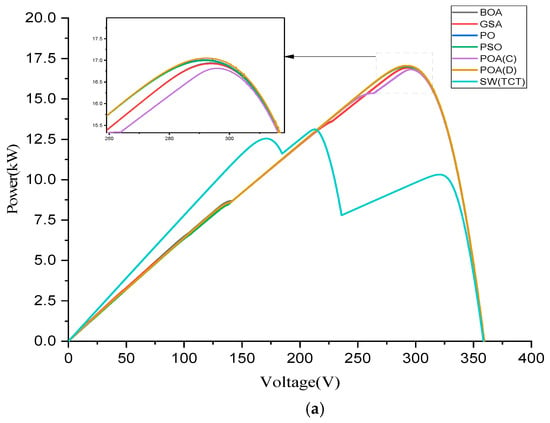
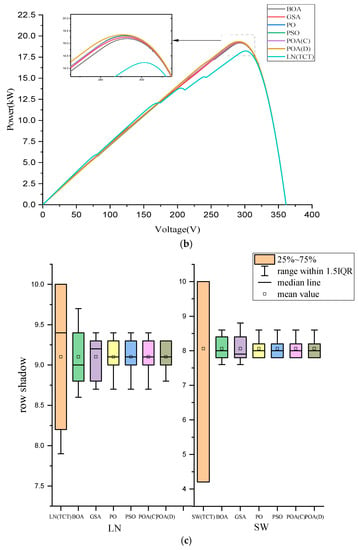
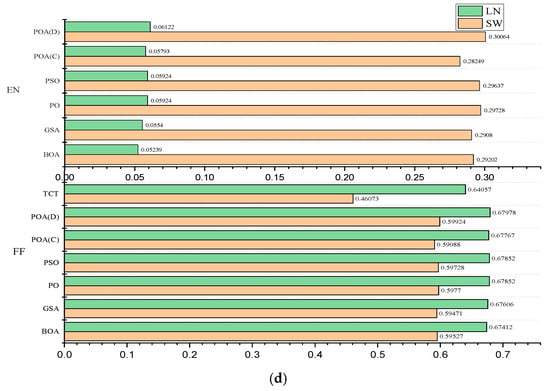
Figure 5.
Power output of different optimization results. (a) PV curve at short and wide shadow; (b) PV curve at long and narrow shadow; (c) boxplot of descending shadow values; (d) mismatch losses (EN) and fill factor (FF).
4.1.2. Case 2: Long Wide Shadow and Short Narrow Shadow
Figure 6a,b illustrate the distributions of long and wide shadow, and short and narrow shadow, which have four irradiance levels. To assess the reliability of novel objective function with POA, this paper compares it with conventional function with other algorithms, namely the African vulture optimization algorithm (AVOA), GOA and the gray wolf optimization (GWO). The dynamic configuration results are shown in Figure 6a,b.
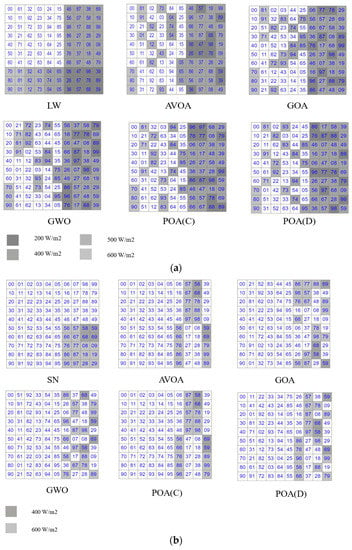
Figure 6.
Optimization results of PV array at different shadows. (a) Long and wide shadow; (b) short and narrow shadow.
Through the analysis of various shadow conditions depicted in Figure 7a,b, it is evident that when a significant portion of the PV array is affected by PSC, the multi-peak phenomenon becomes more prominent in the curve of the PV array. After dynamic reconfiguration (as shown in Figure 7b), the improvement in PV array output power becomes more significant. Compared to all the results, conventional objective function with POA underperforms in achieving the desired results, and the novel objective function with POA can still obtain the maximum output power reconfiguration solution in terms of power optimization.
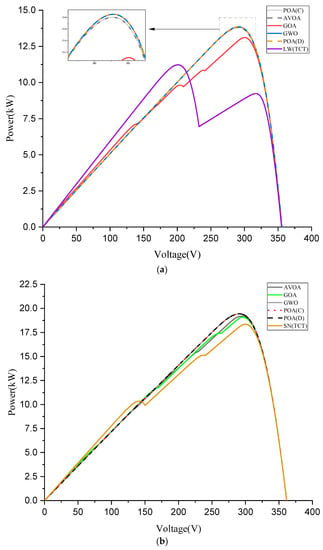
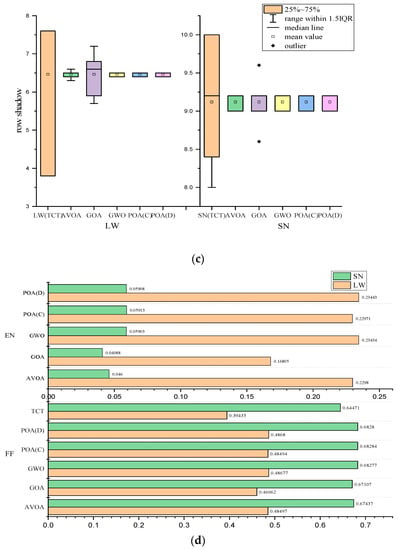
Figure 7.
Power output of different optimization results. (a) PV curve at long and wide shadow; (b) PV curve at short and narrow shadow; (c) boxplot of descending shadow values; (d) mismatch losses (EN) and fill factor (FF).
4.2. Switching Action Optimization
This section is concerned with optimizing the switching action of the PV array. When the weight α in the novel objective function is adjusted as 0, 0.01, 0.05, 0.1, 0.25 and 0.5, the dynamic reconfiguration result with novel function and the electrical position invariant ratio f2 are illustrated in Figure 8. As α is limited within the range of , we can prioritize maximizing the power output and then seek to minimize the switch actions as much as possible. In Figure 9, larger weight values reduce the switching actions and also decrease the output power. As the α value increases, the PV cells at lower shading values have less influence on the overall power output of the array, and their electrical positions are given less priority during the dynamic reconfiguration process. Therefore, adjusting the weight value α allows for the effective prioritization of the reconfiguration of PV cells based on their shading levels, thereby enhancing the overall performance of the PV array.
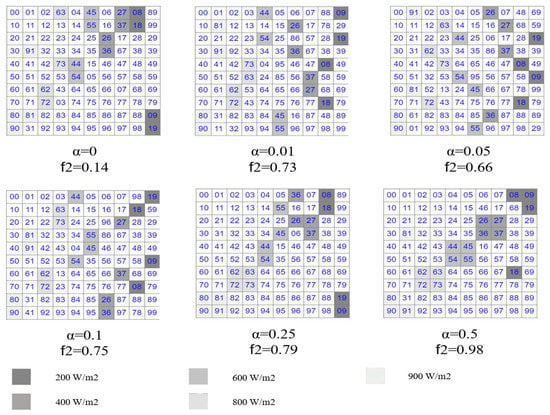
Figure 8.
Diagonal shadow and optimization results.
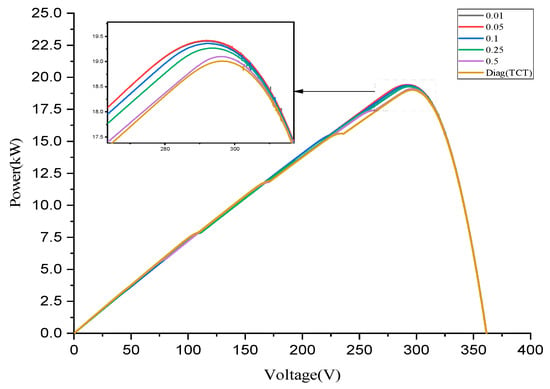
Figure 9.
PV curves under diagonal shading.
5. Conclusions
This article proposes a novel objective function that simultaneously considers power maximization and switching action minimization. The Pelican Optimization Algorithm is employed to explore the optimal solution of the novel objective function and accomplish the dynamic reconfiguration of the PV array. The key achievements of this article are as follows:
- (1)
- In terms of the power optimization: By using the new composite objective function with POA, the efficiency of PV array output under PSC has been effectively improved. The simulation results for four different modes demonstrate that it can achieve the same or even better maximum power optimization compared to traditional objective functions.
- (2)
- In terms of the switching action optimization: The novel composite objective function, which combines power optimization and switch action optimization using weights, generates a unique optimization solution. Switch action optimization during reconfiguration not only enhances power generation efficiency, but also further reduces the complexity of switch control. However, this column-wise optimization strategy is prone to getting trapped in local optima.
- (3)
- The improved POA resolves the issue of the discretization caused by the combination of objective functions with weights. Building upon this, during PV array reconfiguration, multiple factors are combined to form a single objective function. This facilitates the reconfiguration under different conditions, thereby enhancing operational flexibility. The improved POA can allow the optimization to be performed in a discrete space, omitting the process of converting a discrete variable into a continuous variable and then back into a discrete variable. This greatly simplifies the optimization process.
Author Contributions
Conceptualization, S.L. and T.Z.; methodology, S.L. and T.Z.; software, T.Z., S.L. and J.Y.; validation, S.L. and T.Z.; formal analysis, S.L. and T.Z.; investigation, S.L., T.Z. and J.Y.; resources, S.L. and J.Y.; data curation, T.Z.; writing—original draft preparation, S.L. and T.Z.; writing—review and editing, S.L. and T.Z. All authors have read and agreed to the published version of the manuscript.
Funding
This work was supported by the University Student Innovation and Entrepreneurship Training Program Project of Jiangsu Province (202011276009Z), and the Scientific Research Foundation of Nanjing Institute of Technology (ZKJ202102).
Data Availability Statement
The data presented in this study are available upon request from the corresponding author.
Conflicts of Interest
The authors declare no conflict of interest.
References
- Li, S.; Lu, Y.; Ge, Y. Static Voltage Stability Zoning Analysis Based on a Sensitivity Index Reflecting the Influence Degree of Photovoltaic Power Output on Voltage Stability. Energies 2023, 16, 2808. [Google Scholar] [CrossRef]
- Meydani, A.; Meidani, A.; Shahablavasani, S. Clean Energy’s Role in Power Plant Development. In Proceedings of the 2023 8th International Conference on Technology and Energy Management (ICTEM), Babol, Iran, 8–9 February 2023; pp. 1–7. [Google Scholar]
- Krishna, S.G.; Moger, T. Improved SuDoKu reconfiguration technique for total-cross-tied PV array to enhance maximum power under partial shading conditions. IEEE Trans. Energy Conver. 2019, 34, 1973–1984. [Google Scholar] [CrossRef]
- Chaibi, Y.; Malvoni, M.; Chouder, A.; Boussetta, M.; Salhi, M. Simple and efficient approach to detect and diagnose electrical faults and partial shading in photovoltaic systems. Energy Convers. Manag. 2019, 196, 330–343. [Google Scholar] [CrossRef]
- Pillai, D.S.; Ram, J.P.; Nihanth, M.S.S.; Rajasekar, N. A simple, sensorless and fixed reconfiguration scheme for maximum power enhancement in PV systems. Energy Convers. Manag. 2018, 172, 402–417. [Google Scholar] [CrossRef]
- Baka, M.; Manganiello, P.; Soudris, D.; Catthoor, F. A cost-benefit analysis for reconfigurable PV modules under shading. Sol. Energy 2019, 178, 69–78. [Google Scholar] [CrossRef]
- Belhachat, F.; Larbes, C. PV array reconfiguration techniques for maximum power optimization under partial shading conditions: A review. Sol. Energy 2021, 230, 558–582. [Google Scholar] [CrossRef]
- Malathy, S.; Ramaprabha, R. Reconfiguration strategies to extract maximum power from photovoltaic array under partially shaded conditions. Renew. Sust. Energy Rev. 2018, 81, 2922–2934. [Google Scholar] [CrossRef]
- Horoufiany, M.; Ghandehari, R. Optimization of the Sudoku based reconfiguration technique for PV arrays power enhancement under mutual shading conditions. Sol. Energy 2018, 159, 1037–1046. [Google Scholar] [CrossRef]
- Vijayalekshmy, S.; Bindu, G.R.; Iyer, S.R. Analysis of various photovoltaic array configurations under shade dispersion by Su Do Ku arrangement during passing cloud conditions. Indian J. Sci. Technol. 2015, 8, 1–7. [Google Scholar] [CrossRef]
- Potnuru, S.R.; Pattabiraman, D.; Ganesan, S.I.; Chilakapati, N. Positioning of PV panels for reduction in line losses and mismatch losses in PV array. Renew. Energy 2015, 78, 264–275. [Google Scholar] [CrossRef]
- Tatabhatla, V.M.R.; Agarwal, A.; Kanumuri, T. Performance enhancement by shade dispersion of Solar Photo-Voltaic array under continuous dynamic partial shading conditions. J. Clean. Prod. 2019, 213, 462–479. [Google Scholar] [CrossRef]
- Dhanalakshmi, B.; Rajasekar, N. Dominance square based array reconfiguration scheme for power loss reduction in solar PhotoVoltaic (PV) systems. Energy Convers. Manag. 2018, 156, 84–102. [Google Scholar] [CrossRef]
- Dhanalakshmi, B.; Rajasekar, N. A novel competence square based PV array reconfiguration technique for solar PV maximum power extraction. Energy Convers. Manag. 2018, 174, 897–912. [Google Scholar] [CrossRef]
- Rakesh, N.; Madhavaram, T.V. Performance enhancement of partially shaded solar PV array using novel shade dispersion technique. Front. Energy 2016, 10, 227–239. [Google Scholar] [CrossRef]
- Samikannu, S.M.; Namani, R.; Subramaniam, S.K. Power enhancement of partially shaded PV arrays through shade dispersion using magic square configuration. J. Renew. Sustain. Energy 2016, 8, 063503. [Google Scholar] [CrossRef]
- Yadav, A.S.; Pachauri, R.K.; Chauhan, Y.K.; Choudhury, S.; Singh, R. Performance enhancement of partially shaded PV array using novel shade dispersion effect on magic-square puzzle configuration. Sol. Energy 2017, 144, 780–797. [Google Scholar] [CrossRef]
- El Iysaouy, L.; Lahbabi, M.; Oumnad, A. A novel magic square view topology of a PV system under partial shading condition. Energy Procedia 2019, 157, 1182–1190. [Google Scholar] [CrossRef]
- Sanseverino, E.R.; Ngoc, T.N.; Cardinale, M.; Vigni, V.L.; Musso, D.; Romano, P.; Viola, F. Dynamic programming and Munkres algorithm for optimal photovoltaic arrays reconfiguration. Sol. Energy 2015, 122, 347–358. [Google Scholar] [CrossRef]
- Velasco-Quesada, G.; Guinjoan-Gispert, F.; Piqué-López, R.; Román-Lumbreras, M.; Conesa-Roca, A. Electrical PV array reconfiguration strategy for energy extraction improvement in grid-connected PV systems. IEEE Trans. Ind. Electron. 2009, 56, 4319–4331. [Google Scholar] [CrossRef]
- Santos, P.; Vicente, E.M.; Ribeiro, E.R. Reconfiguration methodology of shaded photovoltaic panels to maximize the produced energy. In Proceedings of the XI Brazilian power electronics conference, Natal, Brazil, 11–15 September 2011; pp. 700–706. [Google Scholar]
- Parlak, K.S. PV array reconfiguration method under partial shading conditions. Int. J. Elect. Power Energy Syst. 2014, 63, 713–721. [Google Scholar] [CrossRef]
- Mahmoud, Y.; El-Saadany, E. Fast reconfiguration algorithm for improving the efficiency of PV systems. In Proceedings of the 2017 8th International Renewable Energy Congress (IREC), Amman, Jordan, 21–23 March 2017; pp. 1–5. [Google Scholar]
- Deshkar, S.N.; Dhale, S.B.; Mukherjee, J.S.; Babu, T.S.; Rajasekar, N. Solar PV array reconfiguration under partial shading conditions for maximum power extraction using genetic algorithm. Renew. Sust. Energy Rev. 2015, 43, 102–110. [Google Scholar] [CrossRef]
- Babu, T.S.; Ram, J.P.; Dragičević, T.; Miyatake, M.; Blaabjerg, F.; Rajasekar, N. Particle swarm optimization based solar PV array reconfiguration of the maximum power extraction under partial shading conditions. IEEE Trans. Sustain. Energy 2017, 9, 74–85. [Google Scholar] [CrossRef]
- Fathy, A. Recent meta-heuristic grasshopper optimization algorithm for optimal reconfiguration of partially shaded PV array. Sol. Energy 2018, 171, 638–651. [Google Scholar] [CrossRef]
- Yousri, D.; Allam, D.; Eteiba, M.B. Optimal photovoltaic array reconfiguration for alleviating the partial shading influence based on a modified harris hawks optimizer. Energy Convers. Manag. 2020, 206, 112470. [Google Scholar] [CrossRef]
- Fathy, A. Butterfly optimization algorithm based methodology for enhancing the shaded photovoltaic array extracted power via reconfiguration process. Energy Convers. Manag. 2020, 220, 113115. [Google Scholar] [CrossRef]
- Hasanien, H.M.; Al-Durra, A.; Muyeen, S. Gravitational search algorithm-based photovoltaic array reconfiguration for partial shading losses reduction. In Proceedings of the 5th IET International Conference on Renewable Power Generation (RPG) 2016, London, UK, 21–23 September 2016; pp. 1–6. [Google Scholar]
- Rajan, N.A.; Shrikant, K.D.; Dhanalakshmi, B.; Rajasekar, N. Solar PV array reconfiguration using the concept of Standard deviation and Genetic Algorithm. Energy Procedia 2017, 117, 1062–1069. [Google Scholar] [CrossRef]
- Yousri, D.; Babu, T.S.; Beshr, E.; Eteiba, M.B.; Allam, D. A robust strategy based on marine predators algorithm for large scale photovoltaic array reconfiguration to mitigate the partial shading effect on the performance of PV system. IEEE Access 2020, 8, 112407–112426. [Google Scholar] [CrossRef]
- Zhang, X.; Meng, D.; Li, W.; Yu, T.; Fan, Z.; Hao, Z. Evolutionary based Pareto optimization algorithms for bi-objective PV array reconfiguration under partial shading conditions. Energy Convers. Manag. 2022, 271, 116308. [Google Scholar] [CrossRef]
- Winston, D.P.; Karthikeyan, G.; Pravin, M.; JebaSingh, O.; Akash, A.; Nithish, S.; Kabilan, S. Parallel power extraction technique for maximizing the output of solar PV array. Sol. Energy 2021, 213, 102–117. [Google Scholar] [CrossRef]
- Nguyen, D.; Lehman, B. A reconfigurable solar photovoltaic array under shadow conditions. In Proceedings of the 2008 Twenty-Third Annual IEEE Applied Power Electronics Conference and Exposition, Austin, TX, USA, 24–28 February 2008; pp. 980–986. [Google Scholar]
- Trojovský, P.; Dehghani, M. Pelican optimization algorithm: A novel nature-inspired algorithm for engineering applications. Sensors 2022, 22, 855. [Google Scholar] [CrossRef]
Disclaimer/Publisher’s Note: The statements, opinions and data contained in all publications are solely those of the individual author(s) and contributor(s) and not of MDPI and/or the editor(s). MDPI and/or the editor(s) disclaim responsibility for any injury to people or property resulting from any ideas, methods, instructions or products referred to in the content. |
© 2023 by the authors. Licensee MDPI, Basel, Switzerland. This article is an open access article distributed under the terms and conditions of the Creative Commons Attribution (CC BY) license (https://creativecommons.org/licenses/by/4.0/).